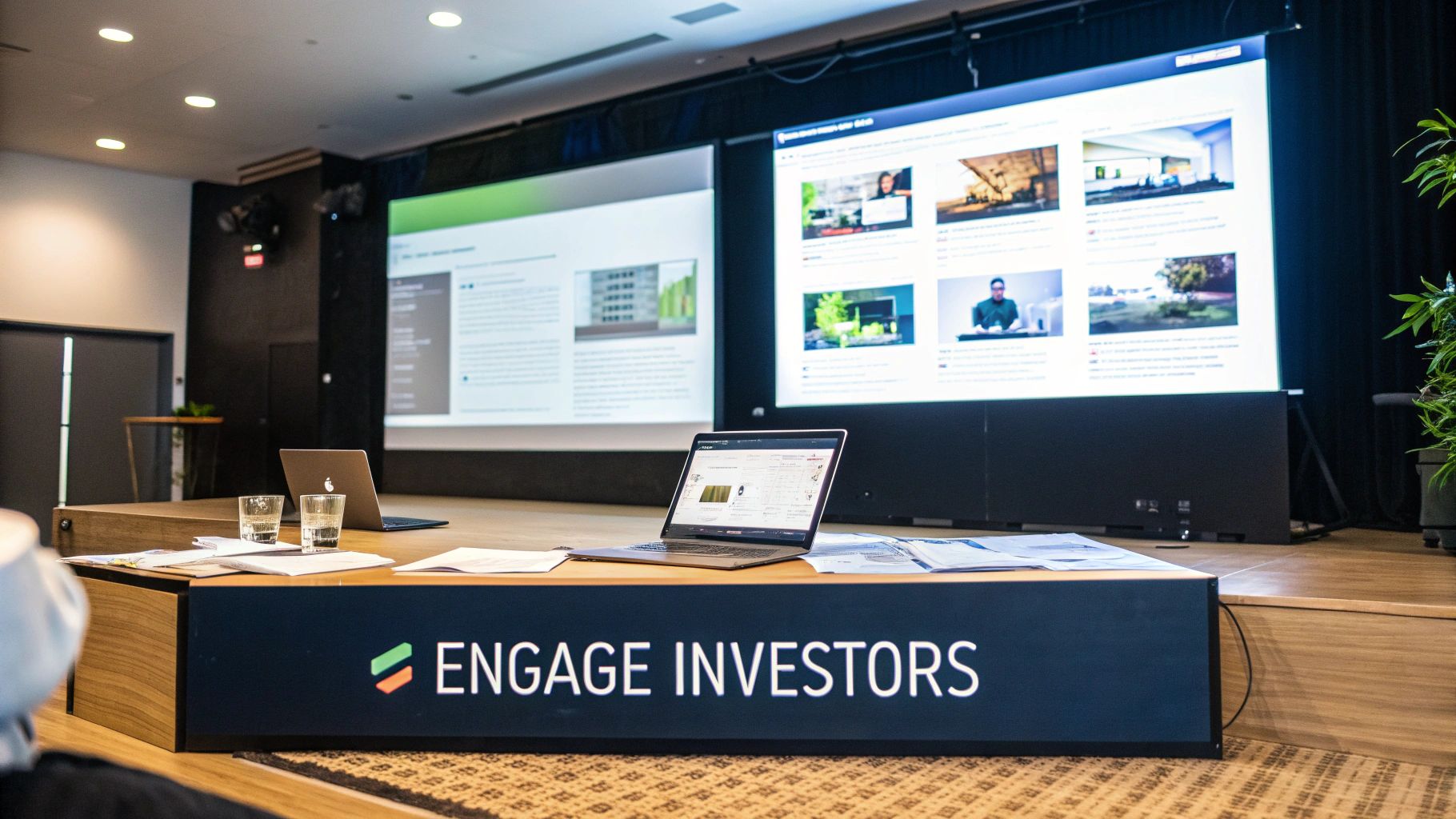Navigating Today's Startup Funding Landscape

Securing capital for your startup is crucial for bringing your vision to life. But it's more than just asking for money. It requires a deep understanding of the funding ecosystem and how to position your company effectively. Let's explore the complexities of raising startup capital in today’s market.
Understanding the Funding Lifecycle
The startup funding journey typically progresses through distinct stages, each with specific expectations and timelines. Think of it like climbing a mountain. You begin at base camp (pre-seed), set up camps along the way (seed, Series A, Series B, etc.), and ultimately reach the summit (IPO or acquisition). Each stage demands different tools and strategies.
Raising startup capital often means navigating various funding rounds, each with its own set of challenges and opportunities. For example, the average time from Seed to Series A funding is about 18 months. The jump from Series A to Series B usually takes between 10 and 18 months.
In 2024, the venture capital landscape showed some recovery, especially in later stages. Series B startups saw a 17.3% increase in capital raised compared to the prior year. Series C startups experienced a significant 41.8% growth.
This suggests investors are becoming more selective, focusing on quality over quantity. This is particularly true in early stages, as seed-stage startups raised 12.5% less capital in 2024. You can find more detailed statistics here: https://www.embroker.com/blog/startup-statistics/
This shift underscores the need to understand the unique dynamics of each funding round to prepare effectively and secure needed capital at the right time.
To further illustrate the varying timelines and expectations at each funding stage, let's examine the following table:
Funding Stages Timeline & Expectations
Comparison of different funding stages, showing typical timelines, investment amounts, and investor expectations
| Funding Stage | Typical Timeline | Average Investment | Investor Expectations |
|---|---|---|---|
| Pre-Seed | 3-6 months | $10k - $500k | Strong team, innovative idea, market potential |
| Seed | 6-12 months | $500k - $2M | Early traction, product-market fit, scalable business model |
| Series A | 12-18 months | $2M - $15M | Proven traction, strong revenue growth, expanding market share |
| Series B | 18-24 months | $15M - $50M | Rapid scaling, market leadership, path to profitability |
| Series C+ | 24+ months | $50M+ | Sustainable growth, expansion into new markets, preparation for IPO or acquisition |
Note: These are average figures and can vary based on industry, location, and specific company circumstances.
This table highlights the progressive nature of funding. As a startup matures, the investment amounts increase, alongside investor expectations for growth and profitability. Early-stage investors focus on potential, while later-stage investors seek concrete results.
Decoding Investor Expectations
Investor expectations shift with each funding stage. Early-stage investors (pre-seed and seed) focus on the team, the problem being addressed, and the potential of the proposed solution. As your startup grows (Series A and beyond), investors prioritize traction, revenue growth, and a clear path to profitability.
For example, a pre-seed investor might be swayed by a passionate founder with a groundbreaking idea, even with a product in its infancy. A Series B investor, however, expects demonstrated market traction, a scalable business model, and a robust management team.
Adapting to Market Conditions
Market conditions significantly impact investment decisions. Understanding these dynamics is essential for fundraising success. During economic downturns, investors become more risk-averse, favoring startups with solid fundamentals and a clear path to profitability. During economic expansion, investors are often more willing to bet on early-stage startups with high growth potential.
Industry-specific trends also play a key role. Sectors like artificial intelligence or renewable energy might attract more investment during specific times due to investor interest or regulatory changes. Staying aware of these trends and positioning your startup accordingly can greatly improve your funding prospects. Adapting your strategy to current market realities strengthens your case to potential investors, increasing your chances of success.
Getting Your Startup Investment-Ready

Attracting investors is essential for any startup. But it takes more than a good idea. You need to present it in a way that grabs investors' attention and shows you're ready to grow. This means addressing their concerns and showcasing your potential.
Building a Compelling Business Plan
A strong business plan is the bedrock of any successful funding request. It's a roadmap for your startup's journey and demonstrates your market knowledge. This plan needs to clearly define your value proposition, target market, competitive landscape, and how you'll make money.
Telling a compelling story is crucial. Investors invest in stories, not just products or services. Your business plan should be engaging and showcase your startup's potential. Explain why your startup matters, not just what it does.
For example, focus on how your product solves a customer problem, not just its features. Emphasize the positive impact your startup will have and the value it creates for investors.
Developing Realistic Financial Projections
Financial projections give investors a look into your startup's future. These projections must be realistic and data-driven. Avoid overly optimistic forecasts. Investors need to see you’ve considered market dynamics and potential challenges. They want to see a sustainable business model that generates consistent returns.
Factor in market size, growth rate, customer acquisition cost, and operating expenses. Be ready to explain your assumptions and methodology. A solid financial model builds confidence and demonstrates your financial understanding.
Startup valuations fluctuate with market trends and investor confidence. Early-stage valuations peaked in Q1 2022, with seed-stage valuations reaching $12.9 million in Q1 2023. Late-stage valuations hit $80 million in Q3 and Q4 2021, dropping to $55 million by Q1 2023. This volatility shows increased investor caution. For more detailed statistics, check out this resource: https://kruzeconsulting.com/blog/startup-statistics/
Demonstrating Traction and Milestones
Traction is vital for attracting investors. Even early on, demonstrating some traction can significantly boost your funding chances. This could include early customer adoption, pilot programs, or partnerships. These achievements offer tangible proof of your progress and validate your business model.
Clearly explain your key milestones and achievements. Show how these demonstrate your ability to execute your business plan and reach your goals. Investors want to see progress and momentum, so highlighting your accomplishments is essential.
Organizing Your Due Diligence Documents
Organized documentation is essential for smooth due diligence. Investors need to evaluate your startup's legal, financial, and operational status. Provide easy access to important documents:
- Incorporation documents: These prove your startup's legal structure.
- Financial statements: These show past performance and future projections.
- Intellectual property documentation: Include any patents, trademarks, or copyrights.
- Key agreements: Provide contracts with customers, suppliers, or partners.
Readily available documents streamline the due diligence process and show you're prepared. This speeds up the funding process and builds trust.
Following these steps significantly improves your odds of securing funding. Careful preparation demonstrates your investment readiness and positions your business for success. It also lets you accurately assess your valuation and negotiate better terms. Securing funding is a partnership, and being prepared builds trust for a successful long-term relationship.
Traditional Paths to Raise Startup Capital

Securing funding for your startup can feel like navigating a maze. But understanding the traditional funding routes can make the journey much smoother. This section explores these well-established methods, providing insights into their pros, cons, and ideal fit for different stages of a startup’s lifecycle.
Venture Capital
Venture capital (VC) firms invest in high-potential startups with ambitious growth trajectories. VC funding typically comes in staged rounds (Series A, B, C, etc.), each progressively larger, fueling expansion and market disruption. However, this capital comes at a price. VC firms often require substantial equity and have a say in company decisions.
- Advantages: Significant capital infusion, access to industry experts, and valuable networking opportunities.
- Disadvantages: Ownership dilution, pressure for rapid growth, and potential loss of control.
Angel Investors
Angel investors are individuals who invest their personal funds in early-stage ventures. Often, they bring not just money but also mentorship and guidance, which can be invaluable, especially for first-time founders. Angel investments are typically smaller than VC rounds, making them a good fit for bootstrapped companies or those seeking pre-seed or seed funding. However, the level of industry expertise among angel investors can vary.
- Advantages: Lower initial investment requirements, mentorship opportunities, and a typically quicker funding process.
- Disadvantages: Less capital compared to VC, potential misalignment of goals, and a potentially limited network reach.
Accelerators
Startup accelerators offer structured programs with intensive mentorship, resources, and networking opportunities, culminating in a "demo day" where startups pitch to investors. Accelerators can be instrumental in refining business models, building valuable connections, and securing follow-on funding. However, participation usually involves giving up some equity, and the demanding nature of these programs can strain resources and require unwavering dedication.
- Advantages: Structured mentorship programs, access to valuable resources, and increased investor visibility.
- Disadvantages: Equity dilution, intense program demands, and potential incompatibility with some startup models.
Bank Financing
Bank loans offer a non-dilutive funding path, allowing you to retain full ownership of your company. However, they can be challenging to secure for early-stage startups lacking significant assets or a proven revenue stream. This traditional method becomes more accessible as a business matures and demonstrates consistent profitability. Bank loans require repayment with interest and strong financials.
- Advantages: No equity dilution, predictable repayment schedule, and established lending processes.
- Disadvantages: Difficult for early-stage companies to obtain, often requires collateral or robust financials, and entails fixed repayment obligations.
Choosing the Right Path
The ideal funding source depends on various factors, including your industry, stage of development, growth projections, and risk tolerance. For instance, a biotech startup with lengthy R&D timelines might be better suited for VC funding, while a consumer product company might find success with crowdfunding or angel investors.
To help visualize the different options, let's take a look at a comparison table:
Comparison of Traditional Funding Sources Analysis of different funding options with their requirements, investment ranges, and ideal startup profiles
| Funding Source | Typical Investment Range | Equity Requirements | Best For | Timeline |
|---|---|---|---|---|
| Venture Capital | $1M+ | 20-40% | High-growth, scalable businesses | Months |
| Angel Investors | $10k-$1M | 5-20% | Early-stage, pre-seed/seed | Weeks-Months |
| Accelerators | Varies (often includes seed funding) | 5-10% | Early-stage, high-growth potential | Program-specific (3-6 months) |
| Bank Loans | $10k+ | None | Established businesses with strong financials | Months |
This table summarizes the key differences between traditional funding sources. Consider your startup's specific needs and the trade-offs involved when making your decision.
The funding landscape is also significantly influenced by prevailing market conditions and investor sentiment. Recent years have witnessed a shift toward strategic investments in high-growth sectors like healthcare and AI. This trend has increased the focus on profitability, especially for later-stage companies. Valuations in this segment experienced a significant drop from $600 million in Q1 2022 to $90 million by Q1 2023. Conversely, the median deal size and valuation across most funding series have generally increased, partly due to substantial investments in AI. For deeper insights into these trends, check out this resource: https://foundershield.com/blog/startup-survival-guide-essential-venture-capital-statistics/
Successfully navigating the funding process requires a thorough understanding of each option and a well-defined strategy for approaching potential investors. This includes a comprehensive business plan, realistic financial projections, and demonstrable traction. By aligning your funding strategy with your startup’s specific needs and the current market climate, you can greatly improve your chances of securing the capital necessary for success.
Beyond VC: Alternative Ways to Fund Your Startup

While venture capital remains a popular funding avenue, exploring alternative routes can be essential, especially in today's competitive market. This section explores various funding options outside of VC and offers insights into how these methods can help your startup thrive.
Crowdfunding: Tapping Into the Power of the Crowd
Crowdfunding has become a powerful way to raise startup capital. Platforms like Kickstarter and Indiegogo allow you to present your idea to a broad audience and receive funding from individuals interested in supporting your project.
This approach can generate substantial capital, build early brand awareness, and validate market demand.
For example, Oculus VR raised over $2.4 million on Kickstarter, showcasing crowdfunding's potential for ambitious ventures. This initial success was instrumental in their eventual acquisition by Facebook for $2 billion.
Revenue-Based Financing: Fueling Growth Without Dilution
Revenue-based financing presents a non-dilutive funding option where you receive capital in exchange for a percentage of future revenue. This model aligns investor incentives with your company's success. Investors only profit if your business generates revenue.
This can be appealing for founders who want to retain equity. Additionally, revenue-based financing is more flexible than traditional loans, with repayments tied to actual revenue performance. This benefits startups with fluctuating cash flow.
Grant Programs: Securing Non-Dilutive Capital
Various grant programs offer non-dilutive capital to startups developing innovative projects or tackling specific societal challenges. These grants, often from government agencies, foundations, or corporations, can be competitive but offer significant funding without equity dilution.
However, grant applications require careful planning and a compelling narrative aligned with the grant provider’s mission. Thorough research and a well-crafted application are essential for securing these funds.
Strategic Partnerships: Leveraging Synergies for Growth
Forming strategic partnerships can provide both capital and valuable market access. Collaborating with established companies in your industry can provide access to funding, distribution channels, and valuable industry expertise.
This collaborative approach can be especially effective for startups looking to establish themselves in a competitive market. For example, partnering with a large retailer could offer a startup access to a vast customer base, significantly accelerating growth. This can be more valuable than capital alone.
Venture Debt: Bridging the Gap Between Funding Rounds
Venture debt is a loan designed for venture-backed companies. It supplements equity funding rounds, extending runway and providing additional capital for growth initiatives. While more flexible than traditional loans, venture debt usually includes warrants or other equity-linked components.
This funding method suits companies with a strong track record and clear revenue projections, as lenders carefully assess the company's ability to repay. Used correctly, venture debt can be a valuable tool for scaling your business.
By understanding these alternative funding options, startups can diversify their fundraising strategies and select the best methods for their needs and goals. These avenues offer ways to raise capital beyond traditional VC, offering founders greater control and flexibility. Careful evaluation of each option, combined with a clear understanding of your startup's stage and objectives, can significantly influence your funding success and long-term growth.
Crafting a Pitch That Actually Gets Funded
Raising startup capital often depends on a truly compelling pitch. It's not simply about showcasing your product. It's about forging a genuine connection with investors and painting a clear picture of your vision for the future. This involves understanding investor motivations and weaving a narrative that captures their interest and ultimately secures their investment.
Structuring Your Story for Maximum Impact
Your pitch should tell a captivating story. This narrative should highlight the problem your startup solves and emphasize its potential for substantial returns. Clearly articulating your value proposition, explaining your target market, and demonstrating how your solution addresses a market need are essential elements.
For example, instead of just listing features, focus on your product's positive impact on customers. Share compelling customer testimonials or showcase real-world use cases. This approach resonates more deeply with investors.
Designing Slides That Support Your Narrative
Your pitch deck should enhance your message, not distract from it. Each slide should serve a clear purpose, contributing to the overall narrative. Avoid cluttered slides filled with excessive information. Choose concise messaging and impactful visuals that underscore your key takeaways.
Consider using visuals like charts and graphs to present market size and projected growth. Visuals can effectively communicate complex information in an accessible format. Your slides should act as a visual aid that complements your spoken presentation.
Delivering Your Pitch With Confidence and Authenticity
Authenticity is paramount when pitching. Passion for your startup is infectious. Investors are investing not just in your product, but also in you as the founder. They seek dedicated leaders with a clear vision and the ability to execute.
Practice your pitch thoroughly to guarantee a smooth, confident delivery. Anticipate potential investor questions and prepare thoughtful answers. Being prepared showcases your expertise and builds confidence in your ability to navigate challenges. A composed response to difficult questions can leave a lasting positive impression.
Tailoring Your Message to Different Investor Personas
Investors, like customers, have diverse needs and motivations. Understanding the priorities of various investor types, like angel investors versus venture capitalists, is vital. Tailor your pitch to resonate with each specific audience, highlighting aspects that align with their investment criteria.
For example, an angel investor might be drawn to your personal story and passion, while a VC might prioritize market size and scalability. Adapting your pitch demonstrates an understanding of investor perspectives, improving your chances of securing funding.
Creating Momentum and Following Up Strategically
A successful pitch extends beyond the presentation itself. It involves building momentum and following up effectively. After your pitch, send a concise thank-you email summarizing key points and reiterating your value proposition.
Maintain consistent communication with potential investors, providing updates on your progress and milestones. Nurturing these relationships is crucial for long-term success. Ongoing dialogue keeps you top-of-mind and positions you favorably for future funding rounds. Securing funding isn't a single event; it marks the start of a lasting partnership.
Building Investor Relationships That Last
Securing funding is a major accomplishment, but it's only the first step. The real journey begins after the investment comes through, as you cultivate and maintain lasting relationships with your investors. These relationships, nurtured effectively, can become your startup's most valuable resource, providing far more than financial support.
Communication Is Key: Keeping Investors Engaged
Open and regular communication is essential for a strong investor relationship. This doesn't mean overwhelming them with constant updates. Rather, it means providing frequent, concise, and insightful reports on your company's progress. Imagine giving your investors a clear roadmap – showing them your goals, your progress, and any obstacles you encounter.
Using well-designed reporting templates can simplify this process. These templates should emphasize key performance indicators (KPIs), milestones reached, and upcoming challenges. Such transparency builds trust and keeps investors well-informed without overwhelming them.
Leveraging Your Investor Network
Investors are more than just financial backers; they are a network of seasoned professionals with valuable connections. Successful founders strategically tap into these networks, seeking introductions to potential clients, partners, and even future investors. Consider your investors an extension of your team, offering guidance and unlocking opportunities.
Navigating Difficult Conversations
Not every discussion with investors will be a cause for celebration. Missed targets and unexpected shifts in strategy are unavoidable parts of the startup world. The key is to approach these conversations with honesty and transparency. Explain the obstacles faced, the lessons learned, and the revised plan of action. This open communication maintains trust, even during tough times.
Productive Board Meetings: Making Every Minute Count
Board meetings are vital points of contact with your investors. Prepare diligently for these meetings, presenting key metrics, addressing challenges, and outlining future strategies. These meetings should be more than simple updates; they are opportunities to seek strategic advice and utilize the combined expertise of your board.
Securing Future Funding Rounds
A strong relationship with current investors can be invaluable for obtaining future funding. Their continued support and positive feedback can significantly influence potential new investors. Keep them informed about your progress and future funding strategies, demonstrating the continued growth potential of your startup.
Handling Investor Transitions
Investor transitions are a common occurrence in the startup ecosystem. Whether due to fund lifecycles or changes in investment strategies, these transitions must be managed smoothly. Maintain open communication with departing investors, ensuring a seamless handover and preserving the valuable connections they've provided.
Building strong investor relationships requires effort, but the benefits are immeasurable. These partnerships, when nurtured correctly, offer more than just capital; they offer guidance, mentorship, and access to a powerful network. By prioritizing communication, transparency, and mutual respect, you can transform your investors into your startup's biggest champions, propelling long-term success.
Ready to deepen your understanding of startup growth? Explore inspiring stories and practical strategies on The Covered Call Podcast.

